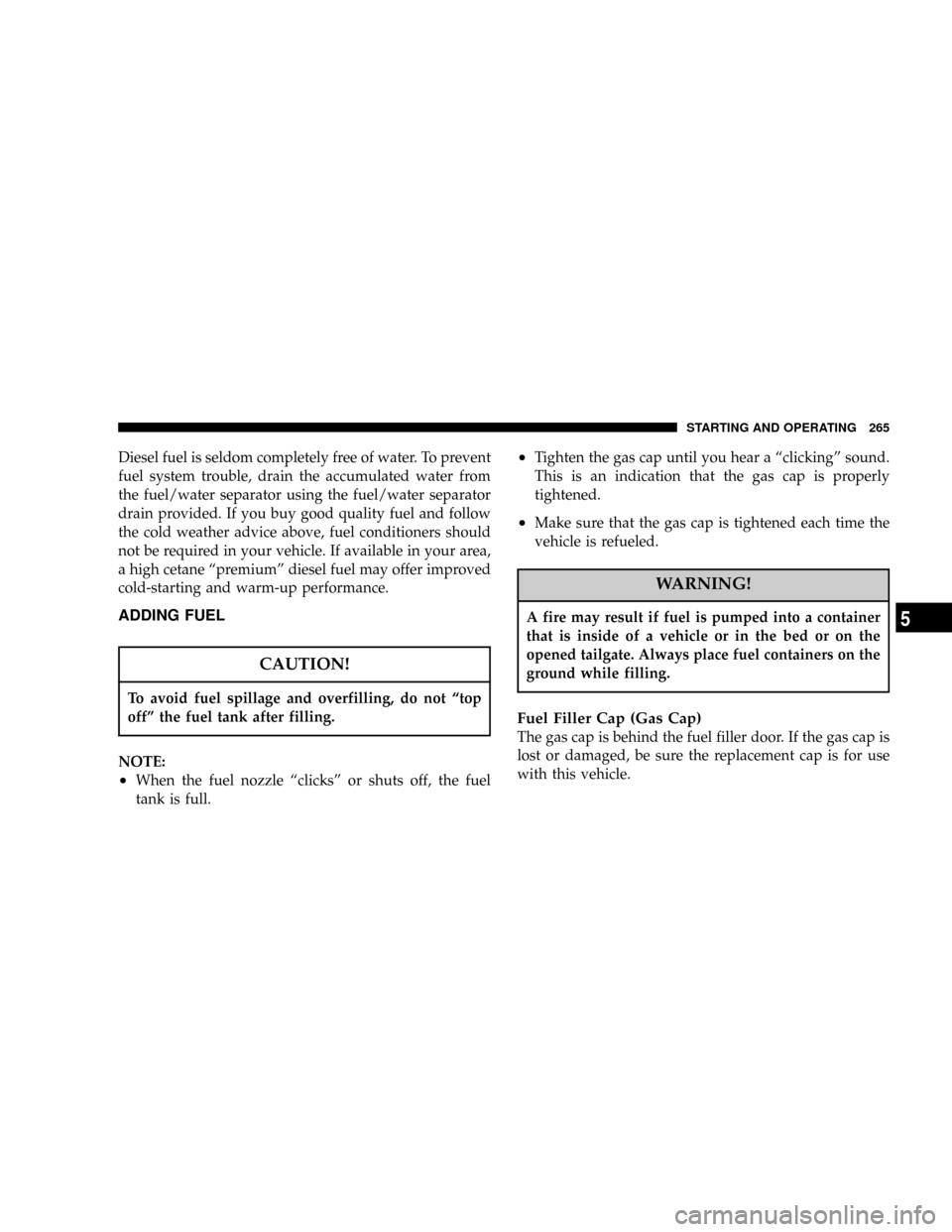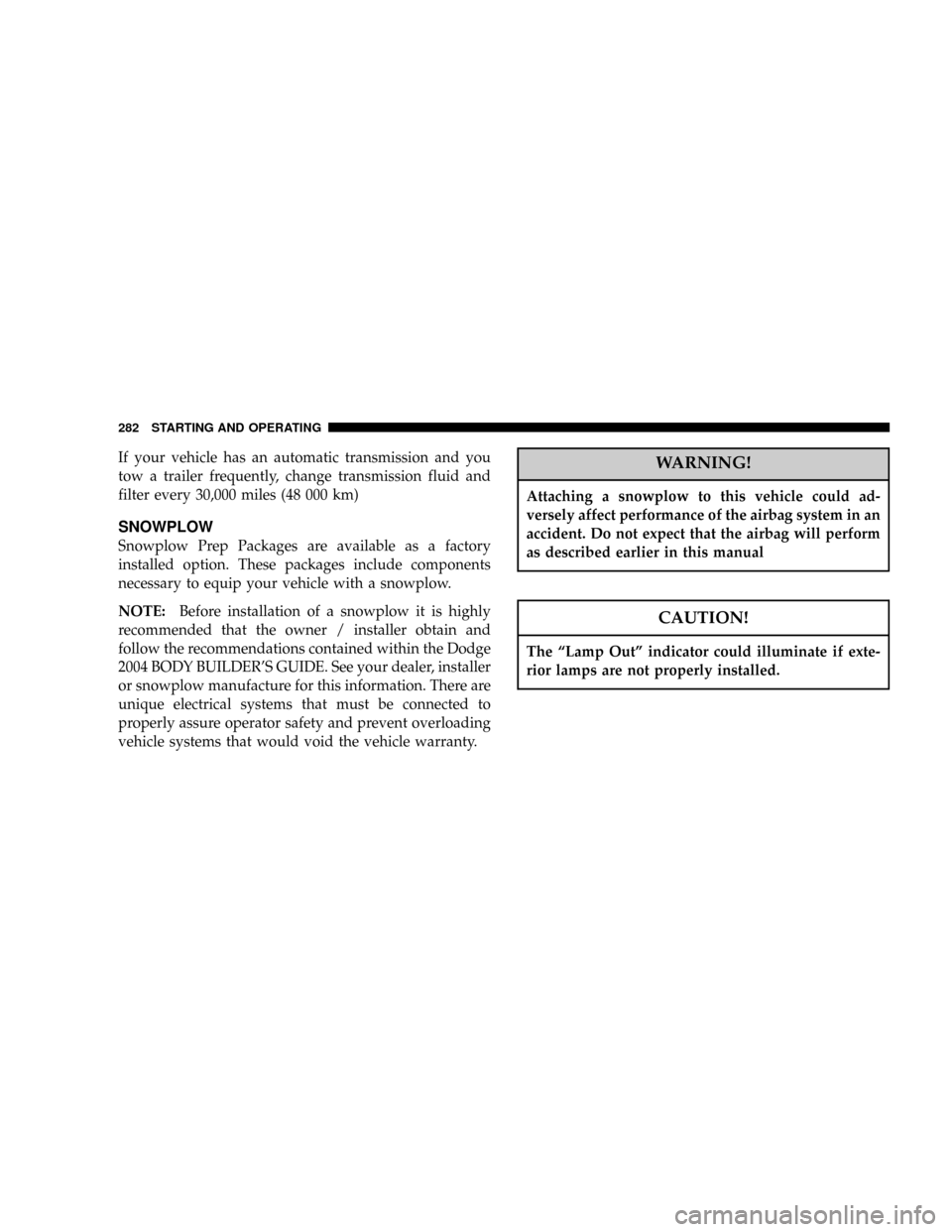Page 265 of 426

Diesel fuel is seldom completely free of water. To prevent
fuel system trouble, drain the accumulated water from
the fuel/water separator using the fuel/water separator
drain provided. If you buy good quality fuel and follow
the cold weather advice above, fuel conditioners should
not be required in your vehicle. If available in your area,
a high cetane ªpremiumº diesel fuel may offer improved
cold-starting and warm-up performance.
ADDING FUEL
CAUTION!
To avoid fuel spillage and overfilling, do not ªtop
offº the fuel tank after filling.
NOTE:
²When the fuel nozzle ªclicksº or shuts off, the fuel
tank is full.
²Tighten the gas cap until you hear a ªclickingº sound.
This is an indication that the gas cap is properly
tightened.
²Make sure that the gas cap is tightened each time the
vehicle is refueled.
WARNING!
A fire may result if fuel is pumped into a container
that is inside of a vehicle or in the bed or on the
opened tailgate. Always place fuel containers on the
ground while filling.
Fuel Filler Cap (Gas Cap)
The gas cap is behind the fuel filler door. If the gas cap is
lost or damaged, be sure the replacement cap is for use
with this vehicle.
STARTING AND OPERATING 265
5
Page 266 of 426
CAUTION!
Damage to the fuel system or emission control
system could result from using an improper fuel
tank filler tube cap (gas cap). A poorly fitting cap
could let impurities into the fuel system.
WARNING!
²Remove the fuel tank filler tube cap (gas cap)
slowly to prevent fuel spray from the filler neck
which may cause injury.
²The volatility of some fuels may cause a buildup
of pressure in the fuel tank that may increase
while you drive. This pressure can result in a
spray of fuel and/or vapors when the cap is
removed from a hot vehicle. Removing the cap
slowly allows the pressure to vent and prevents
fuel spray.
²Never have any smoking materials lit in or near
the vehicle when the gas cap is removed or the
tank filled.
²Never add fuel to the vehicle when the engine is
running.
266 STARTING AND OPERATING
Page 274 of 426

must be considered as part of the total load on your
vehicle. Refer to the Certification label located at the
driver's door for the Gross Vehicle Weight Rating.
WARNING!
Improper towing can lead to an injury accident.
Follow these guidelines to make your trailer towing
as safe as possible:
Axle Lubricant and Trailer Towing
2500/3500 Models
²
The Axles on 2500/3500 Modelsare trailer tow ready
andDO NOT REQUIREany special axle lubes or
additives.
Trailer Towing Recommendations
²
All trailer hitches should be professionally installed on
your vehicle.
²Safety chains must always be used between your
vehicle and trailer.
²Donotinterconnect the hydraulic brake system or
vacuum system of your vehicle with that of the trailer.
This could cause inadequate braking and possible
personal injury. An electrically±actuated electric trailer
brake controller is recommended.
²Trailer brakes are recommended for trailers over 1000
lbs (454 kg) and are required for trailers in excess of
2,000 lbs (907 kg)
274 STARTING AND OPERATING
Page 281 of 426

²Highway DrivingÐreduce your speed.
²Air ConditioningÐturn it off temporarily.
²Hilly TerrainÐTurn overdrive off.
See Cooling System Operating information in the Service
and Maintenance section of this manual for more infor-
mation.
Automatic Transmission Oil Temperature Warning
Light
All vehicles with heavy duty transmission oil cooling are
equipped with a transmission sump oil temperature
sensor and warning light. If elevated transmission tem-
peratures are encountered, the engine controller will
select the most desirable gear until the transmission
temperatures are reduced. If transmission oil tempera-
tures continue to rise, a warning light located in theinstrument cluster will illuminate. If this should occur,
stop the vehicle, shift to Neutral, and run the engine at
idle or faster until the light goes off.
Towing With An Automatic Transmission
Vehicles equipped with an automatic transmission may
shift into and out of Overdrive, or a lower gear, when
driving in hilly areas, when heavily loaded, or when
towing into heavy winds.
When this condition occurs, press the ªTOW/HAULº
button or shift into a lower gear to prevent excessive
transmission wear and/or overheating, and to provide
better engine braking.
NOTE:Do not exceed the following RPM while manu-
ally downshifting:
²5.9L Diesel Engines 3200 RPM.
STARTING AND OPERATING 281
5
Page 282 of 426

If your vehicle has an automatic transmission and you
tow a trailer frequently, change transmission fluid and
filter every 30,000 miles (48 000 km)
SNOWPLOW
Snowplow Prep Packages are available as a factory
installed option. These packages include components
necessary to equip your vehicle with a snowplow.
NOTE:Before installation of a snowplow it is highly
recommended that the owner / installer obtain and
follow the recommendations contained within the Dodge
2004 BODY BUILDER'S GUIDE. See your dealer, installer
or snowplow manufacture for this information. There are
unique electrical systems that must be connected to
properly assure operator safety and prevent overloading
vehicle systems that would void the vehicle warranty.
WARNING!
Attaching a snowplow to this vehicle could ad-
versely affect performance of the airbag system in an
accident. Do not expect that the airbag will perform
as described earlier in this manual
CAUTION!
The ªLamp Outº indicator could illuminate if exte-
rior lamps are not properly installed.
282 STARTING AND OPERATING
Page 288 of 426

4. Shift automatic transmission to N (NEUTRAL), or
depress the clutch on manual transmissions.
5. Shift transfer case lever to desired position.
6. Shift automatic transmission into P (Park).
WARNING!
You or others could be injured if you leave the
vehicle unattended with the transfer case in the N
(NEUTRAL) position without first fully engaging
the parking brake. The transfer case N (NEUTRAL)
position disengages both the front and rear drive-
shafts from the powertrain and will allow the ve-
hicle to move regardless of the transmission posi-
tion. The parking brake should always be applied
when the driver is not in the vehicle.
CAUTION!
²Do not use a bumper mounted clamp-on tow bar
on your vehicle. The bumper face bar will be
damaged.
²Do not disconnect the rear driveshaft because
fluid will leak from the transfer case and damage
the internal parts.
Recreational Towing Procedure Ð Electronic
Shift Transfer Case Ð If Equipped
Use the following procedure to prepare your vehicle for
recreational towing.
288 STARTING AND OPERATING
Page 292 of 426

WARNING!
You or others could be injured if you leave the
vehicle unattended with the transfer case in the
Neutral (N) position without first fully engaging the
parking brake. The transfer case Neutral (N) position
disengages both the front and rear driveshafts from
the powertrain and will allow the vehicle to move
despite the transmission position. The parking
brake should always be applied when the driver is
not in the vehicle.
CAUTION!
²Do not use a bumper mounted clamp-on tow bar
on your vehicle. The bumper face bar will be
damaged.
²Do not disconnect the rear driveshaft because
fluid will leak from the transfer case and fluid
loss will damage internal parts.
DRIVING OFF-ROAD
Care should be taken when attempting to climb steep
hills or driving diagonally across a hill or slope. If natural
obstacles force you to travel diagonally up or down a hill,
choose a mild angle and keep as little side tilt as possible.
Keep the vehicle moving and make turns slowly and
cautiously.
292 STARTING AND OPERATING
Page 295 of 426
WHAT TO DO IN EMERGENCIES
CONTENTS
mHazard Warning Lights..................296
mAdding Fuel Ð 24±Valve Cummins Turbo
Diesel...............................297
mJack Location..........................298
NAll Models..........................298
mChanging A Flat Tire....................299
NRemoving The Spare Tire................299
NTire Changing Procedure................300
mHoisting.............................309mJump-Starting.........................310
NWith Portable Starting Unit..............313
mFreeing A Stuck Vehicle..................313
mEmergency Tow Hooks Ð If Equipped........314
mTowing A Disabled Vehicle................315
N4-Wheel- Drive Vehicles.................315
N2±Wheel- Drive Vehicles................315
6